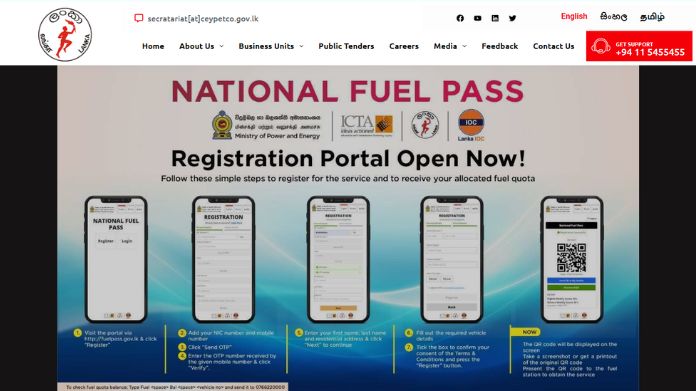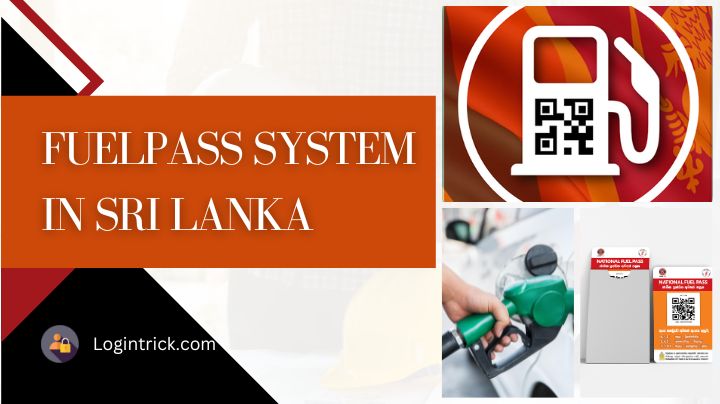Embarking on a journey through the intricate labyrinth of the FuelPass System in Sri Lanka can be both an enlightening and essential endeavor for every vehicle owner in the country.
Have you ever found yourself overwhelmed by the complexities of fuel allocation, especially in times of scarcity?
The FuelPass System, a revolutionary online platform, promises to redefine your experience with fuel distribution, offering a beacon of efficiency and fairness in challenging times.
Here, Logintrick.com unravels the layers of this innovative system, and don’t hesitate to share your insights and experiences.
Your voice is vital in shaping how we all can better understand and utilize the FuelPass System for a smoother, more equitable fuel distribution journey.
What is the FuelPass System?
The FuelPass system is an online platform developed by the Sri Lankan government. It aims to regulate and distribute fuel efficiently across the nation, especially during periods of scarcity or economic downturn.
By implementing a quota-based system, it ensures a more equitable distribution of fuel resources among citizens.
Accessing the System: The Login Process
Accessing the FuelPass System is a straightforward process designed to ensure ease of use and efficiency.
This system, crucial for managing fuel distribution in Sri Lanka, requires users to complete a simple yet secure login procedure.
Here’s a step-by-step guide to help you get started:
- Website Navigation: Begin by visiting the official FuelPass System website. You can find it by searching for ‘fuelpass gov lk’ in your web browser. This site is the gateway to accessing your fuel quota and managing your bookings.
- Account Creation for New Users: If you’re a new user, your first step will be to create an account. Look for a registration or sign-up option on the homepage. This process usually involves providing basic personal details, such as your name, contact information, and relevant vehicle details. It’s essential to have your vehicle information handy, as this will be crucial for the fuel allocation process.
- Verification Process: After you’ve entered your details, the system will typically require you to undergo a verification process. This step is vital for security purposes and might involve receiving a verification code via SMS or email. Follow the instructions provided to complete this stage.
- Logging In: Once your account is set up and verified, return to the main page of the FuelPass System website. Here, you will find the login section. Enter the username and password you created during the registration process. If you’ve forgotten your password, there’s usually an option to reset it through a linked email or phone number.
- Accessing the Dashboard: After successfully logging in, you’ll be directed to your user dashboard. This area is the control center for your interactions with the system. It typically displays your current fuel quota, recent transactions, booking options, and sometimes notifications about updates or changes in the system.
- Navigating the System: Take some time to familiarize yourself with the dashboard. Explore the various features and options available. You’ll find that you can check your fuel quota, book fuel slots, and see your transaction history, among other functionalities.
Navigating the Dashboard

Navigating the dashboard of the FuelPass System is crucial for efficiently managing your fuel allocations and bookings.
The dashboard is designed to be user-friendly and informative, providing a comprehensive overview of your fuel usage and options.
Here’s a guide to help you understand and make the most out of the dashboard features:
- Overview of the Dashboard: After successfully logging in, you will be presented with the main dashboard. This interface is your central hub for all activities related to the FuelPass System. It’s typically organized into various sections for ease of use.
- Fuel Quota Information: One of the primary features of the dashboard is the display of your fuel quota. This section shows the amount of fuel you are allocated, often with details on the type of fuel and the validity period. It’s important to keep an eye on this area to understand your current fuel entitlements.
- Booking Management: The dashboard allows you to manage your fuel bookings. You can book your fuel allocation slots based on the available quota. This section usually includes options to select the fuel type, choose a fuel station, and pick a convenient time slot for refueling.
- Transaction History: A detailed log of your past transactions can be found in this section. This includes your previous fuel bookings, the amount of fuel dispensed, and the dates of transactions. Reviewing this history helps you track your fuel usage over time.
- Notifications and Alerts: Receive notifications and alerts about updates or changes in the FuelPass System. This could include information about changes in quota, system updates, or important announcements relevant to fuel distribution.
- Profile Management: In this area, you can manage your details, vehicle information, and contact preferences. Keeping this information up-to-date is essential for the smooth functioning of your account.
- Support and Help: If you have questions or encounter issues, the dashboard often includes a help or support section. This might offer FAQs, contact information for customer support, or a guide to using the system more effectively.
- Feedback and Suggestions: Some dashboards may include an option to provide feedback or suggestions. Your input can be valuable in improving the system.
- Logging Out: Ensure that you log out of the dashboard after completing your activities, especially if you are using a public or shared computer. This helps maintain the security of your account.
Navigating the dashboard efficiently is key to making the most out of the FuelPass System. Familiarize yourself with its features and functionalities to enhance your experience and manage your fuel needs effectively.
Booking Fuel: A Step-by-Step Process
Booking fuel through the FuelPass System is a streamlined process designed for user convenience. To ensure a smooth experience, it’s important to follow the steps carefully.
Here’s a detailed guide to help you book your fuel allocation:
- Log In to Your Account: Start by logging into your account on the FuelPass System website. Enter your username and password to access your dashboard. This step is crucial as it ensures that your booking is linked to your account and fuel quota.
- Navigate to the Booking Section: Once on the dashboard, look for the booking section. This is typically prominently displayed and easy to find. Here, you will initiate the process of reserving your fuel slot.
- Select Fuel Type: Your first step in the booking process will be to select the type of fuel you need. Options will generally include petrol, diesel, or other fuel types, depending on availability and your vehicle’s requirements.
- Choose a Fuel Station: After selecting the fuel type, you need to choose a fuel station. The system will likely offer a list of participating stations along with their locations. Select the one that is most convenient for you, considering factors like distance and expected wait times.
- Pick a Date and Time Slot: Once you’ve chosen a fuel station, the next step is to select a date and time slot for refueling. The availability of slots will depend on the station’s schedule and your quota. It’s best to book a slot when you’re sure you can make it, as changes or cancellations might be limited.
- Confirm Booking Details: Before finalizing the booking, you will be presented with a summary of your choices, including the type of fuel, the selected station, and the time slot. Review these details carefully to ensure they meet your needs.
- Complete the Booking: If everything looks correct, proceed to confirm and complete your booking. Once confirmed, you should receive a confirmation message or receipt, often via email or SMS. This confirmation is important as it may be required at the time of refueling.
- Prepare for Refueling: On the day of your booking, ensure you have your vehicle and any necessary documents ready. This might include your vehicle registration, the confirmation message, and any identification required by the fuel station.
- Attend Your Booking: Arrive at the fuel station on time for your slot. Present your confirmation and follow any instructions provided by the station staff to receive your allocated fuel.
- Feedback and Follow-up: After refueling, you may receive a notification to provide feedback on your experience. This step is optional but can be valuable for the system’s improvement.
The Benefits of FuelPass
The FuelPass system offers several advantages:
- Efficient Fuel Distribution: It ensures fuel is distributed fairly and efficiently.
- Reduced Queues at Fuel Stations: With pre-booked slots, long queues are significantly reduced.
- Transparency: Users have clear visibility of their fuel quota and usage.
- Ease of Use: The online system is user-friendly and accessible from anywhere.
Limitations and Challenges
Despite its benefits, the FuelPass system has its limitations:
- Internet Accessibility: In regions with poor internet connectivity, accessing the system can be challenging.
- Initial Setup: For those not tech-savvy, the initial setup might be daunting.
- Quota Restrictions: The fixed quota might not meet everyone’s needs, especially in emergencies.
Summing Up!
The Fuel Pass system at Fuelpass gov lk represents a significant step towards modernizing fuel distribution in Sri Lanka. By offering an equitable, transparent, and efficient method of fuel allocation, it addresses many challenges faced by the country in managing its fuel resources.
While there are limitations, the overall impact of the system is positive, providing a model for other nations facing similar challenges. As technology advances and user feedback is integrated, we can expect further enhancements to this crucial service, ensuring it continues to meet the evolving needs of Sri Lankan citizens.
